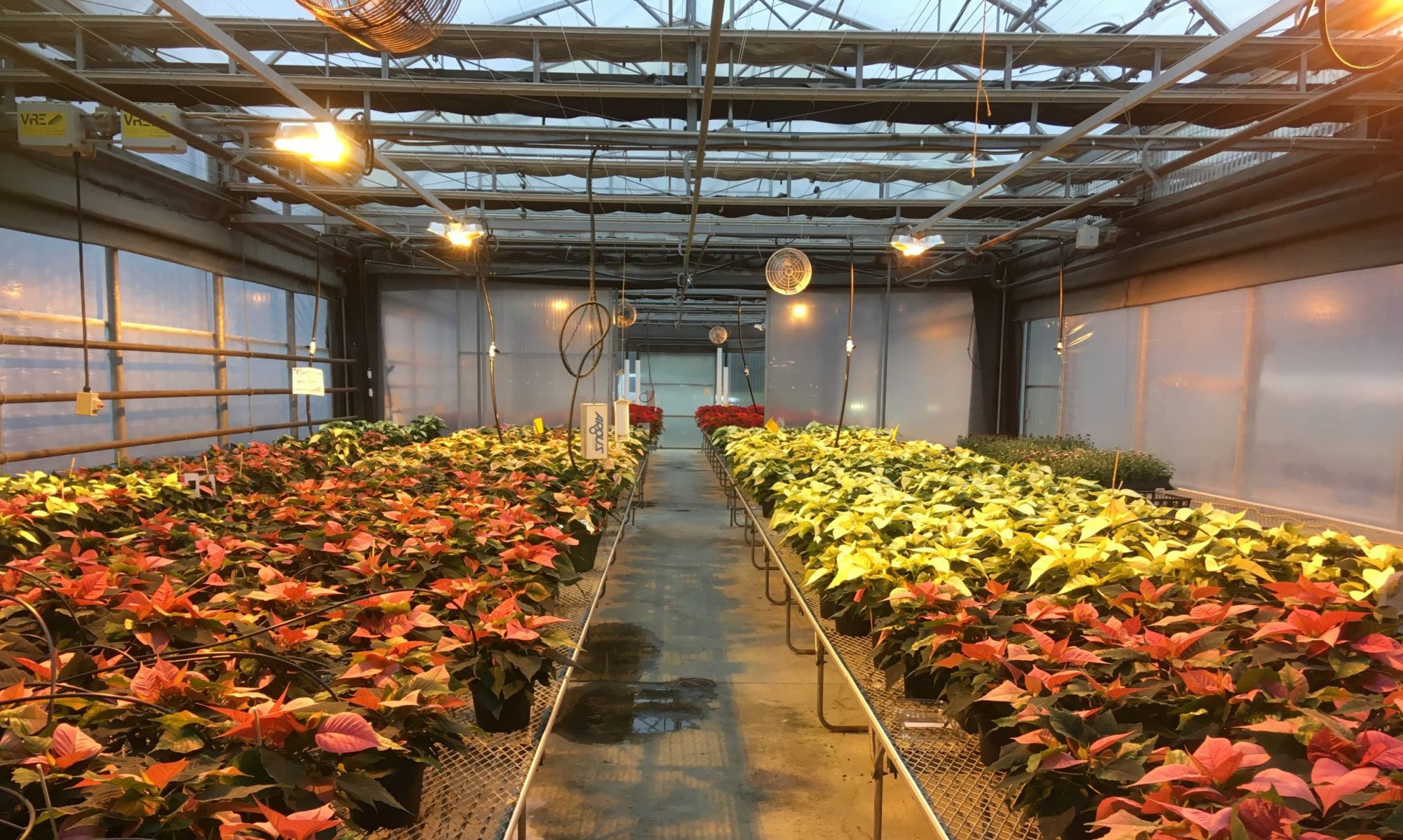To order poinsettias online to go:
https://tradesappliedtech.viu.ca/horticulture/form/poinsettias
Environmental Conditions:

Aside from a couple of rainy days early in the week, week 45 was mostly sunny and very windy. We only have 5 more weeks until sales! Our future classes in the greenhouses will be focused around assessing and grading our poinsettias and changing the environment to prepare the plants for transport.
Day: Heating Setpoint 20C | Cooling Setpoint 22C
Night: Heating Setpoint 18C | Cooling Setpoint 20C
We can really see the height difference in plants in zone 4, where the vent motor is broken and trapping heat in, compared to zone 5 which is functioning properly. I anticipate we will need to raise the day set points in zone 5 to encourage plant growth however, collecting the height information in class on Tuesday, November 10 will give us more direction on this.
All the yellow sticky card assignment labs are complete now. Students will incorporate the data they collect from monitoring and scouting in the greenhouses to make decisions to impact and direct crop growth.
Supplemental Lighting:
We are running a 9-hour day and a 15-hour night to trigger the plants into generative growth. This is essentially what is going to turn our poinsettias red, white, or pink. We just finished week 5 of our blackout period and are seeing colour change throughout the crop and the plants trend towards generative growth.
Hours of Black Out: 15 hours – 5pm to 8am
Nutrient:
EC target is 1.5 – 2.0 pH target is 5.7 – 6.3
EC: Not recorded this week.
pH: Not recorded this week.
Watering/Fertilizer:
I watered the poinsettias on Monday with our high Mg fertilizer, which I am alternating with the CaN03 fertilizer. I spot watered on Friday and anticipate watering again on Monday. Plants, like Titan Pink in zone 3, dry down the fastest because of their large vegetative canopy, established root systems, and proximity to the fans.
Observations:
- We saw lower fungus gnat counts on our yellow sticky cards in zone 5 this week which could indicate to us that removing the flood tables and spacing the 4” plants in trays was beneficial. We need to collect more data and interpret the trends in order to determine if our actions made a long term impact on the growing environment.

2. Students did not take height measurements again this week because we were focusing on the yellow sticky card labs however, the crop visually looks on track as I am working in the greenhouses compared to my prior experience. It is worth noting again that the poinsettias in zone 4 are overall taller than the ones in zone 5 due to the vent being broken. This experience showcases that temperature has a direct influence on crop growth (height). To help regulate temperature fluctuation and to allow air flow, I have left the door between zone 4 and zone 5.
3. Team Grow Getters completed YSC Lab #2 this week and determined that fungus gnat pressures have decreased while whitefly pressures have increased in zone 5. Overall pest pressures are lower in zone 5 than in zone 4. We discuss why in our face to face classes over the coming weeks, hint- temperature not only impacts plant height.
4. We have changed our water management strategy to reduce environments conducive to fungus gnat population growth and applied Hypoaspis miles (predatory mite) and Steinernema feltiae (nematode) as biological controls to reduce fungus gnat populations. We also applied Encarsia formosa and Eretmocerus eremicus cards to combat our Whitefly populations. It’s worth noting that these parasitoid wasps (parasitoids kills their host, parasites need their hosts alive) are applied inside the impregnated whitefly egg – that’s what we see on the cards. This means that the eggs need to hatch, larvae emerge and eat whitefly and then cycle into adult life stages. These parasitoid wasps can take up to two weeks to establish in our greenhouses (insects have fast life cycles, especially at warmer temperatures). When applying our beneficial insects, we need to consider our pest pressures and chose time appropriate beneficials in response to the pressure.
See notes on VIULearn for biological insect applications. https://www.biobestgroup.com/
5. It’s beginning to look a lot like Christmas … too early?
We are seeing increasing amounts of colour change in our crop as we move into the final stages of our crop production. In the upcoming face to face classes we will focus on assessing and grading our plants for sale. We are seeing the difference between our 7.5-week and 8-week response time cultivars. For the last two weeks of production we will reduce fertilizer feed and temperatures to prepare our plants for transport – not everyone has a greenhouse at home! We are also starting to see the first signs of flower development.

6. Moving forward we will continue to monitor plant heights, EC/pH, pest pressures and environmental conditions to make decisions to impact plant health as we head into the final growing stages of our production schedule. After our next face to face classes, students will be able to complete the sale sections of their blogs with this information.
